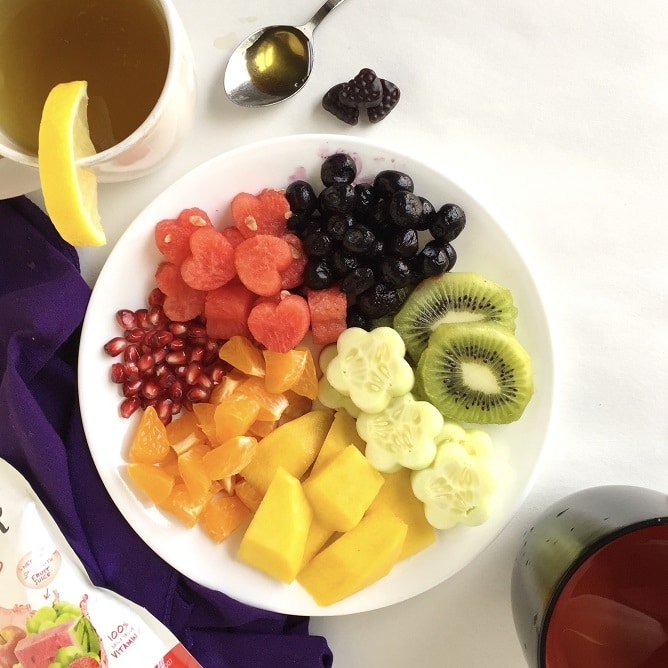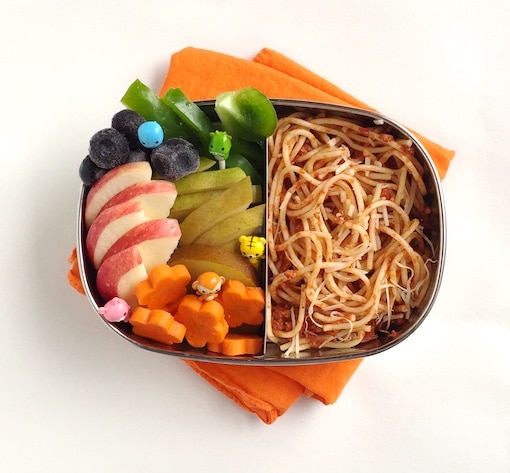What to Feed a Kid That is Throwing Up

I've lived through 2 kids in daycare. It was fun!
Okay, I'm lying. They were sick all the time! And they were even in a really tiny daycare. I also grew up in a big family. Which, means, I was sick all the time as a kid too!
Whether you're dealing with sick kids from daycare, sick kids from school, or sick kids from licking the airport floor (I've been there too), it's hard to watch our babies be so sick.
It's also hard to know what to feed sick kids. Every culture has its own way of feeding kids when they are sick. Different doctors may prescribe different diets. Plus, it really depends what they are sick with. Do they have a fever? Are they throwing up? Diarrhea fun anyone? What foods even stop diarrhea??
Basically, real healthy food will help your child recover the quickest. I don't feed my kids "whatever" just to get them to eat when they are sick. I continue to make the same food I would normally make, but I include more hydrating foods. I also don't pressure them to eat. I stick with the same no-pressure rule that I always have.
Keep reading for more information about how and what to feed a sick kid.
Hydration
This. This is it. I could probably stop right here. No matter if your child has a fever, a cold, diarrhea, or the stomach flu, hydration is the most important thing for kids and toddlers when they are sick.
Dehydration can be serious. If you think your child is dehydrated, call your pediatrician or visit a care provider right away. And of course, call your doctor if your child has a high fever, extended diarrhea or vomiting, or any other extended illness. A few signs of dehydration include:
- Reduced urine
- No tears
- Sunken Cheeks
- Lightheadedness
Let's try to get as much fluid into the child (and keep it there) to avoid dehydration.

Fruits & Veggies
If my child has a fever and can still eat, I provide as many water-filled fruits and veggies as I can. Even if your kids aren't drinking water, they may be able to eat food that has a lot of water in it. Think:
- Watermelon
- Cucumber
- Mango
- Oranges/clementines
- Pomegranate
- Kiwi
- Strawberries
You get the idea. If you need more ideas, the Veggie Exposure Shopping List has a lot more.
If your kiddo has the stomach flu, fruits and veggies probably aren't a good idea. If they have diarrhea, offering a ton of fruit isn't a good idea either, better to offer fruits that don't contribute to diarrhea (more on diarrhea diets below).

Drinks
Obviously, if they aren't eating, drinks are the next thing. If your child is still breastfeeding, giving breastmilk as often as possible is a great source of hydration.
A light cool chamomile tea or other non-caffeinated tea with a bit of honey (after age 1) is an option.
I don't serve juice in the house regularly, but I keep a case of juice boxes on-hand for fevers. I pick a juice box that is primarily water with maybe 25-30% juice. Sometimes my kids just won't drink water at all. In that case, I bring out the juice boxes.
The risk of dehydration far far far outweighs the risk of added sugars in a juice box. I've tried flavored waters (with no added juice) for my kids during fevers. They won't drink them, unfortunately. They are worth a shot though, with your kids.
If the child is vomiting or has diarrhea, I go easy on juice boxes. The fructose from the fruit may make diarrhea worse and the acid from apple, citrus or other juices, may make kids more likely to throw up (although you can try with tiny amounts).
In those cases, or in the case that my children are rejecting juice, I go for an electrolyte replacement drink. There are many of these "sports drinks" and "electrolyte drinks" out there. Are they okay for kids?
First, a note on sports drinks. Many contain dyes and additives that are unhelpful or even dangerous for small kids. Make sure you avoid anything with added caffeine, supplements, or any herbs. It's also smart to avoid synthetic dyes in these drinks. They do cause hyperactivity in some kids (not all kids), and may have other health consequences over time.
You can make your own inexpensive oral rehydration solution using the World Health Organization updated recipe. It is just as effective as expensive rehydration drinks and doesn't contain any unhelpful ingredients and no dyes.
½ teaspoon salt
6 teaspoons sugar
1 liter water
That's it! Shake it up and enjoy. Or, like my kids, spit it out. I think it tastes okay, and it's saved the lives of millions of kids around the world. My kids don't go for it though. I do always try it first, however, because the day they accept it is the day my life gets a lot easier!
Other fluid options:
- Coconut water
- Pedialyte
- Chicken broth or bone broth
- Water-based ice pops
- Homemade juice ice pops
- Ice chips
- Congee (rice water)
I will also add, I've definitely run over to the local convenience store and bought a dye-laden "ade" in a fancy squirt bottle. My son wouldn't drink any of the options that I had in the house. He was dangerously dehydrated and that was my last option.
It did the trick, however, and he drank the enormous bottle in no time. So, priorities. Whatever you need to do to keep them hydrated is the best option!
Be sure to that ice chips and electrolyte drinks are part of your child's vomiting or diarrhea diet.

Meals for Sick Kids
The best foods to feed kids when they are sick are balanced, nutrient-dense meals. Stick to their favorite standard healthy meals when creating their diarrhea diet.
Kids often have a low appetite when they are sick. This is not a good time to force them to eat anything or to buy them French fries, just to get them to eat. My children usually lose a little bit of weight when they get sick, just like I do.
That's okay. I find they usually spend the next 2-3 weeks eating more than usual, as their body recovers. I make sure I make extra hearty nutrient-filled meals (like these ones) so that they can regain what they lost.
I know this can be nerve wracking if your child already has issues with gaining enough weight. I've been there. It's hard to see them lose the 2 pounds that you worked so hard to help them gain. Forcing them to eat when they are sick though, isn't going to help them in the long run.
If your child has had a really low appetite for a long time or you are concerned about the amount of weight they are losing while they are sick, it's a great idea to talk to your pediatrician. They can help you figure out what to do from a medical stand point.

Diarrhea
Is the BRAT Diet Still a Thing?
The BRAT diet for diarrhea is one classic and often suggested diarrhea diet. It consists of: bananas, rice, applesauce, and toast (BRAT). This diet is no longer recommended by the American Academy of Pediaterics. The reason is, it's low in nutrients, fiber, fat and protein. That makes diarrhea last longer than a normal diet does!
It used to be thought that the gut needed to rest to recover from diarrhea or an upset stomach. Now we know better. Children who drink oral rehydration solution to resolve dehydration and eat a balanced diet recover quicker from diarrhea. Nutrients, fiber, fat, and protein help the gut recover from illness.
So, basically, first get the dehydration corrected. Then continue to offer nutritious and balanced meals to children. Continue to also offer rehydration solutions based on how much fluid they are losing.
Source: https://kidseatincolor.com/the-most-important-thing-to-feed-your-child-when-they-are-sick/
0 Response to "What to Feed a Kid That is Throwing Up"
Mag-post ng isang Komento